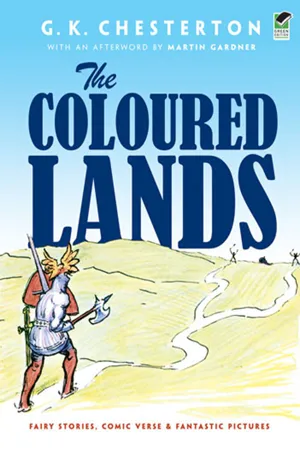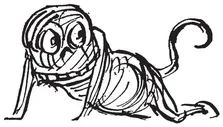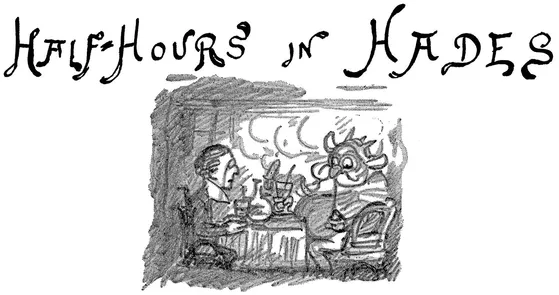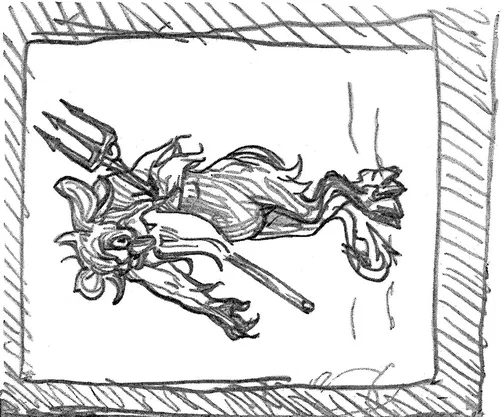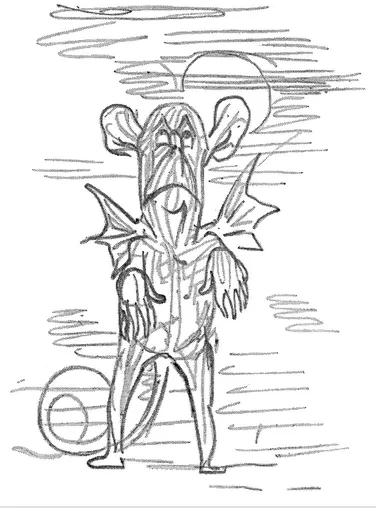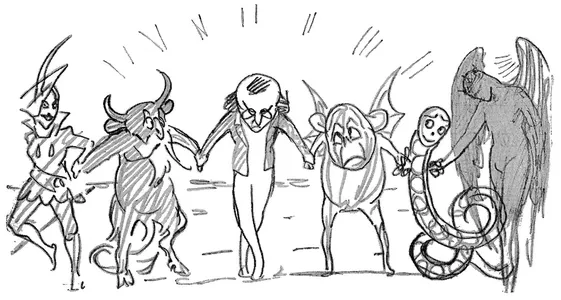PREFACE
IN the autumn of 1890, I was leaving the Casino at Monte Carlo in company with an eminent Divine, whose name, for obvious reasons, I suppress. We were engaged in an interesting discussion on the subject of Demons, he contending that they were an unnecessary, not to say prejudicial, element in our civilisation, an opinion which, needless to say, I strongly opposed. Having at length been so fortunate as to convince him of his error, I proceeded to furnish him with various instances in which Demons have proved beneficial to mankind, and at length he exclaimed, “ My dear fellow, why do you not write a book about——” Here he coughed. The idea took so strong a hold upon me, that from that time I have taken more careful note of the habits and appearance of such specimens as come in my way, and my studies have resulted in the production of this little work, which will, I trust, prove not uninteresting to the youthful seeker after knowledge.
In my capacity as Professor of Supernatural Science at Oxford University, it has often been my duty to call upon an individual who probably knows more about all branches of the subject with which I am about to deal than any man on earth, although no one has yet persuaded him to give his knowledge to the world; and with his permission I have dedicated these pictures to him, as some slight recognition of the wisdom and experience which he has brought to my assistance in the compiling of this modest treatise.
Baron’s Court House, London.
October, 1891.
To that mature personage, the cimmerian nature of whose aspect is popularly supposed to be greatly overrated, this volume is affectionately dedicated.
CHAPTER I
THE FIVE PRIMARY TYPES
Is it not wonderful that so few persons should know anything about the habits and appearance of those whose names are so often on their lips, and who exert so great an influence over all our lives? For those who love the study of Demonology (and I pity the man or woman who does not) it possesses an interest which will remain after health, youth and even life have departed.
It is not my intention in this simple little work to puzzle the young student with any of those dark technicalities of the Science which are only intelligible to such as have studied it for some time. I merely try to put before him, in language as simple as possible, the various species of Demon with which he is most likely to meet, and to explain the organism of any he may have already encountered.
PLATE I. THE COMMON OR "GARDEN" SERPENT (TENTATOR HORTENSIES)
PLATE II THE MEDIAEVAL DEVIL (DIABOLUS FAUNALIUS)
To proceed at once to business, I will first introduce to my young readers the Common, or “Garden” serpent, so-called because its first appearance in the world took place in a Garden. Since that time its proportions have dwindled considerably, but its influence and power have largely increased; it is found in almost everything.
The prejudice entertained by clergymen and others against this insect is most unreasonable and cruel. Were it not for the creature they destroy, their occupation would be gone, like Othello’s. Yet they do all they can to stamp out and crush down this little creature, wherever he may show his hoof.
The next in importance of the specimens of this interesting branch of science is the Mediaeval Demon, whose horns, tail and claws form a remarkable contrast to the serpentine formation of our first type. So wide is the divergence between the two that many modern authorities on the subject put it in an entirely different class to the Common or Garden species, connecting it with an extinct animal of similar formation known as the Faun or Pan, which found its home in many parts of Arcadia. Be this as it may, the Mediaeval Demon is, of all the species, perhaps the one with which we are most familiar; in fact so accustomed are we to the traits and appearance of this remarkable creature that we have more or less taken it under our patronage. It is in a domesticated state the subject rather of playfulness and household merriment than of abhorrence, while the far cleverer and more graceful serpent is the object of a cruel and unreasoning persecution. But useful as the mediaeval species is found at the present day as a general source of amusement, it has of late somewhat failed to stir public interest, which is turned towards newer and more elegant varieties: some of which we shall pass briefly in review. Mr. J. Milton, in his interesting and valuable work on this subject, has discussed at some length the leading characteristics of a fine species of which he was primarily the discoverer, and of which Fig. A. is a sketch. This magnificent animal measures at least four roods, and when floating full length on the warm gulf, of which it is an inhabitant, has been compared by its discoverer to a whale.4
FIG. A. DIABOLUS PARADISI PERDITI
FIG. B. THE RED DEVIL (DIABOLUS MEPHISTOPHILES)
According to Mr. Milton’s theory, this animal is practically identical with the creature represented in Plate I, but, however ably supported, his view has been abandoned by most later authorities. This species is an inhabitant of warm latitudes like most of its kind, being originally found in the burning lakes and dark wildernesses of the most remote parts of the world. Its colour is, generally speaking, dark, but, like most of these creatures, this peculiarity has been much overrated, and Mr. Milton has justly pointed out the “ faded splendour wan ” which imparts a lighter shade to many parts of its exterior.
We now come to the discussion of a very remarkable species which are vulgarly known for the most part by their colour.
The Red Devil (Diabolus Mephistopheles) was discovered by that learned and enterprising German naturalist, Mr. Wolfgang von Goethe, who has published an interesting story of a specimen kept in a domesticated state in the house of his learned fellow-countryman, Dr. Faust. In a domestic state this creature is playful and active, but mischievous and impossible to trust. The learned doctor found it a useful and entertaining companion for many years, but was finally persuaded to part with it, on which it sought the seclusion of its native surroundings. Its colour, as suggested by its name, is, with the exception of its face and hands, a uniform red. Its height is about six feet.
Very different in appearance, yet possessed of one or two of the same habits, is the Blue Devil (Caeruleus Lugubrius). These creatures are gregarious, being usually seen and spoken of in the plural. Though formed by Super-Nature in their habits and exterior apparently for the filling of waste moors, mountains, churchyards and other obsolete places, these animals, like the Red Devil, have frequently been domesticated in rich and distinguished houses, and many of the wealthiest aristocrats and most successful men of commerce may be seen with a string of these blue creatures led by a leash in the street or seated round him in a ring on his own fireside. The noise made by this creature is singularly melancholy and depressing, and its general appearance is far from lively. But though less agile and intelligent than the Red Devil, the sobriety of its habits and demeanour have made it a suitable pet for the houses of clergymen and other respectable persons. To such an extent indeed has this domestication of the Blue Devil been carried, that many persons have denied its connection with the great class we are discussing. There can, however, be no doubt about its origin.
THE BLUE DEVIL (CAERULEUS LUGUBRIUS)
